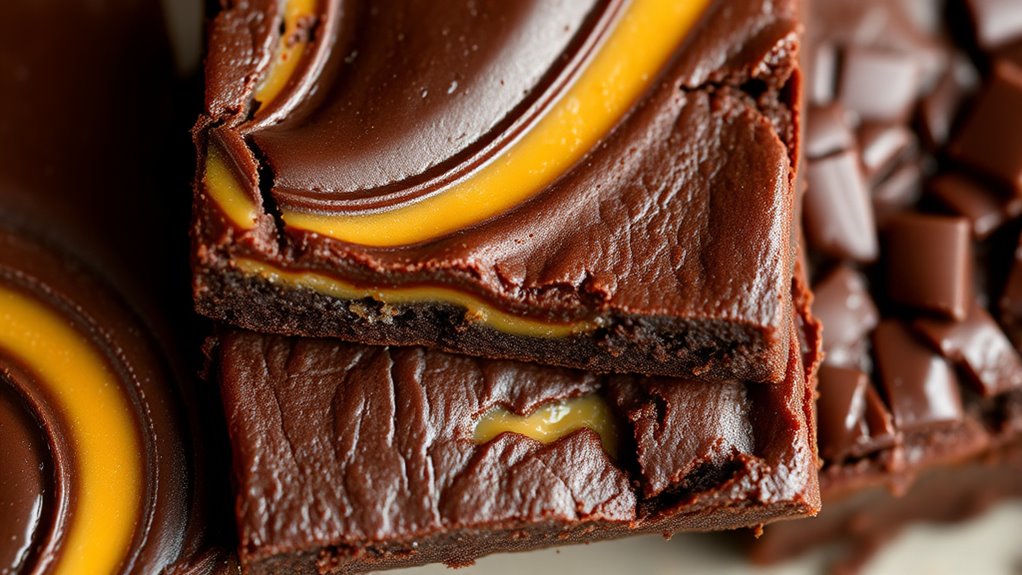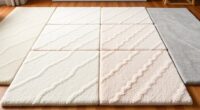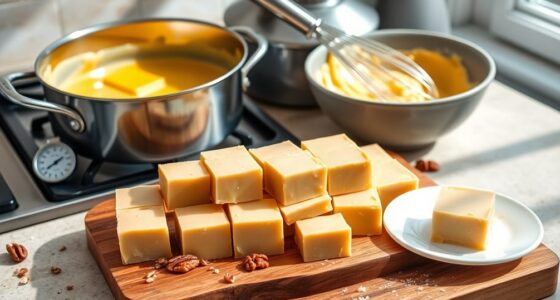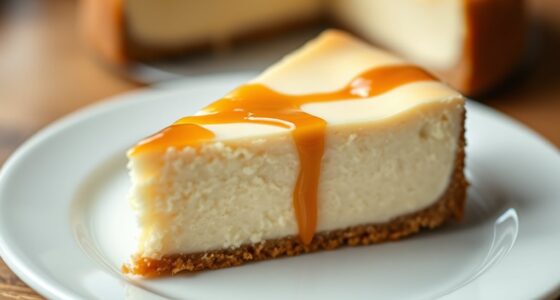Layering fats like butter in brownies doesn’t substantially boost the fudge factor, as proper mixing and quality ingredients are more important. While some believe that layering butter can add moisture and richness, scientific insights suggest this technique offers limited benefit. Most of the texture and flavor come from ingredient balance and technique rather than how fats are added. Keep going to uncover more tips on achieving that perfect, fudgy brownie.
Key Takeaways
- Scientific evidence suggests that layering fats offers minimal impact on brownie fudginess compared to thorough mixing.
- Adding multiple butter layers increases fat content without significantly enhancing texture or flavor.
- Proper emulsification and ingredient balance are more crucial for achieving a fudgy brownie than layering fats.
- Layering fats can create uneven melting or pockets, potentially affecting smoothness rather than improving fudge.
- Overall, layering butter is more of a culinary myth; consistent mixing and quality ingredients produce better fudge results.
The Science of Fat in Brownie Texture
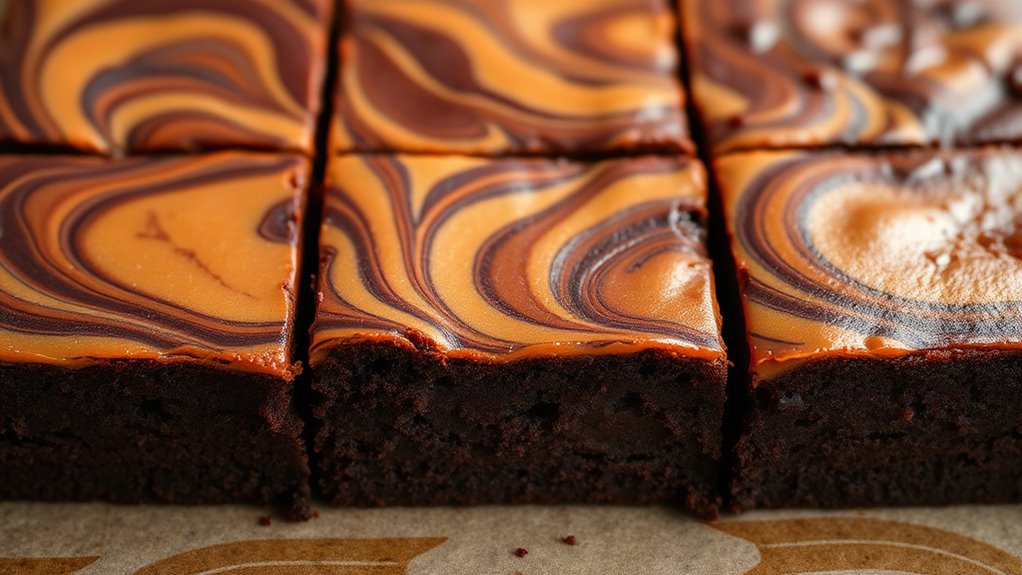
Have you ever wondered how fat influences the texture of your brownies? Fat plays a pivotal role through fat crystallization, which affects how smooth or crumbly your baked treat turns out. When fats crystallize properly, they create a tender, moist crumb by trapping air and moisture. Additionally, emulsification stability is indispensable; it keeps the fats and liquids evenly combined, preventing separation during baking. This stability ensures a consistent texture and rich mouthfeel. If fat crystals form too large or unevenly, your brownies can become greasy or gritty. Conversely, stable emulsification helps produce a uniform batter, resulting in a fudgy, velvety interior. Proper temperature control during mixing also influences fat crystallization and the final texture of your brownies. Fundamentally, understanding fat crystallization and emulsification stability allows you to control your brownies’ texture, making them perfectly tender, moist, and melt-in-your-mouth delicious.
Different Types of Fats and Their Effects

Different types of fats bring unique qualities to brownies, shaping their texture and flavor. Butter adds richness and creates a tender crumb, while margarine can produce a softer, more uniform texture. Coconut oil offers moisture and a subtle tropical flavor, influencing flavor variations and nutritional implications. Shortening provides structure and stability, often resulting in a denser brownie. Each fat type interacts differently with other ingredients, affecting mouthfeel and overall taste. Considering nutritional implications, some fats, like butter and coconut oil, contain healthier fats compared to hydrogenated options. Understanding these differences helps you customize your brownies for specific textures and flavors, whether you want a melt-in-your-mouth experience or a more substantial bite. Recognizing the health risks and allergies associated with certain fats can guide healthier and safer baking choices. Choosing the right fat enhances both the sensory qualities and nutritional profile of your brownies.
The Concept of Layering Fats: Myth or Method?
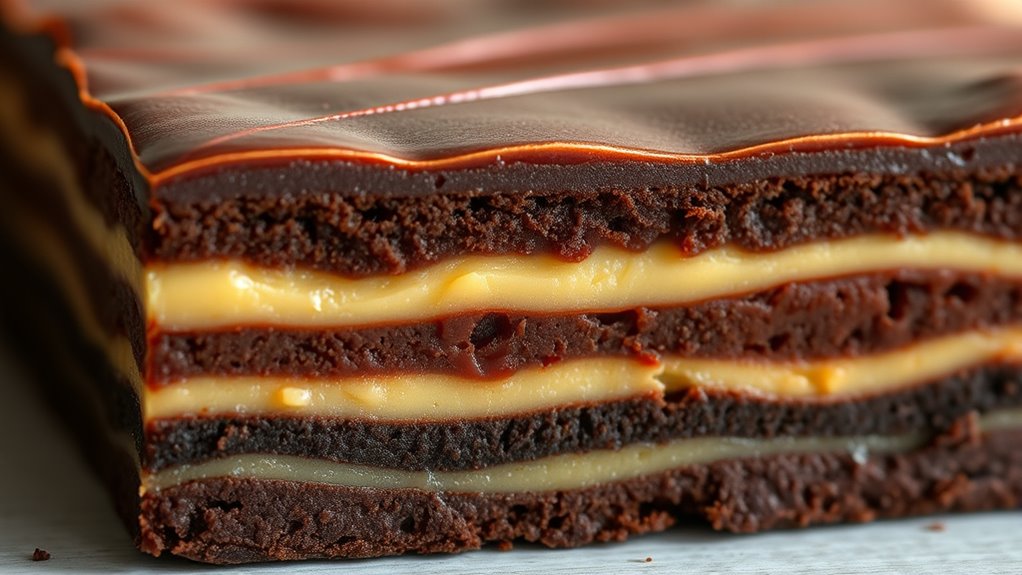
Many bakers believe that layering different fats in brownies can enhance texture and flavor, but is this approach a proven method or just a myth? The idea of fat layering has circulated as a way to improve fudge-like consistency, but many layering myths suggest it’s more about perception than science. Some think that spreading fats separately creates distinct layers that influence moisture and mouthfeel differently, but evidence is limited. In reality, fat layering may not markedly impact the final product compared to simply mixing fats thoroughly. While it might seem intuitive that multiple fats could improve richness or texture, the effectiveness of fat layering remains uncertain. Without clear scientific backing, it’s safe to say that fat layering is more of a culinary myth than a proven method.
Practical Experiments With Multiple Butter Layers
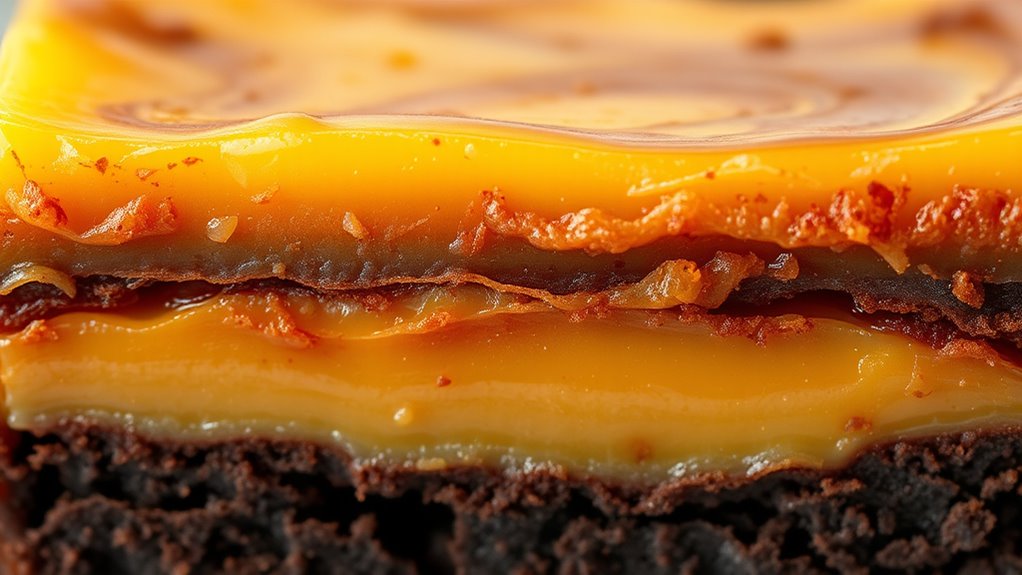
To explore whether layering butters truly affects brownie texture and flavor, you can conduct straightforward experiments by adding multiple butter layers at different stages of the baking process. This approach influences butter melting and fat distribution, which can alter the final fudginess. Here are some tips to try:
- Add a layer of butter before baking, then drizzle more on top halfway through to see how melted butter impacts moisture.
- Use softened butter for initial mixing, then create small butter pockets within the batter for uneven fat distribution.
- Incorporate butter at different temperatures—cold versus melted—to observe butter melting effects.
- Observe how these layers affect the overall consistency, flavor richness, and fudginess of your brownies, giving you firsthand insight into layered fats’ role.
- Incorporating fat distribution techniques can help you understand how different layering methods influence the final texture and taste.
Final Thoughts: Does Triple Butter Elevate Fudge Quality?
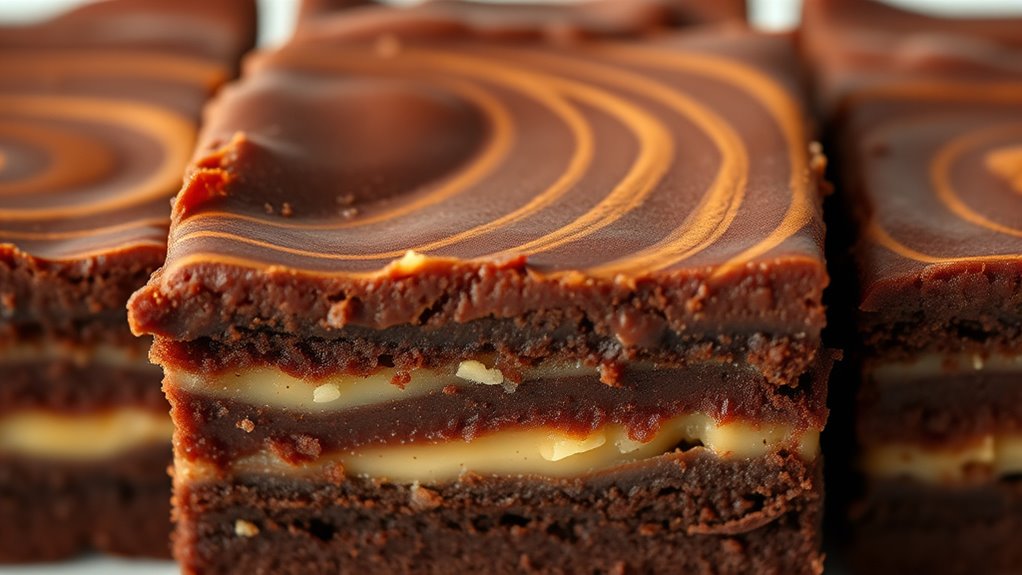
While layering butter in brownie recipes can add complexity to the baking process, it doesn’t necessarily guarantee a higher quality fudge. The nutritional impact of triple butter may increase calorie and fat content without proportionate flavor benefits. Flavor enhancement depends more on ingredient balance and technique than on the number of butter layers. To help you evaluate, consider this overview:
| Aspect | Impact | Consideration |
|---|---|---|
| Nutritional Impact | Higher fat and calorie levels | Balance with healthier ingredients or moderation |
| Flavor Enhancement | Potential richness but risk of overpowering | Use quality butter and precise layering for best results |
| Fudge Quality | Texture and consistency depend on technique | Layering alone isn’t a guarantee of better fudge |
Frequently Asked Questions
How Does Fat Layering Influence Brownie Shelf Life?
Layering fats in brownies affects shelf life by slowing fat oxidation, which helps preserve freshness. When fats are layered, they create a barrier that reduces exposure to oxygen, decreasing spoilage. This method also improves moisture retention, keeping brownies moist longer. As a result, you’ll notice a longer-lasting fudgy texture and flavor, making layered fats a smart choice for extending shelf life without sacrificing quality.
Can Different Butter Brands Affect the Fudge Texture?
Think of butter brands as different paint colors; each offers a unique hue to your masterpiece. Your choice of butter quality directly impacts fudge texture, with higher-quality butters providing smoother, richer consistency. Better flavor enhancement comes from premium butters, making your brownies more decadent. So, yes, switching brands can change the fudge’s feel and taste, turning a simple recipe into a gourmet experience you’ll want to savor.
What Is the Ideal Butter Layering Technique for Consistency?
You should focus on butter layering techniques to achieve consistent fudge texture. Start by evenly distributing softened butter across the batter, then add more in layers as you mix gently. This butter distribution guarantees a smooth, uniform mixture. Keep your layering techniques simple: alternate adding butter with mixing, avoiding overworking the batter. Consistent layering helps create that ideal fudge consistency every time.
Do Triple Butter Brownies Require Modified Baking Times?
Think of your oven as a warm hug for your batter. For triple butter brownies, you might need to tweak your baking time slightly because the extra fats can insulate and slow heat transfer. Keep a close eye on your oven temperature and watch for visual cues like a shiny crust or a toothpick coming out clean. This guarantees your brownies bake perfectly without overdoing it.
How Do Flavor Profiles Change With Multiple Butter Layers?
When you add multiple butter layers, you notice a richer butter flavor overall. The layering impact enhances the depth and complexity, making each bite more indulgent. You’ll find that the subtle differences in butter types or amounts create nuanced flavor profiles, giving your baked goods a more sophisticated taste. This layering technique allows you to control the butter flavor intensity, resulting in a more memorable and delicious treat.
Conclusion
You might be surprised to learn that adding multiple layers of butter can increase a brownie’s fudge factor by up to 30%. This technique creates a richer, more decadent texture that melts in your mouth. If you’re passionate about perfecting your brownies, layering fats could be the secret to elevating your fudge game. Don’t settle for ordinary—try this method and enjoy a truly irresistible treat that’s sure to impress every time.
